Shapes of Cold and Quantum Chaos

Putting sand on the oscillating elastic plate, you can see the formation of Chladni figures . They often serve as an example of the “natural beauty” of physical phenomena, although behind them is the rather simple physics of the resonant excitation of standing waves. And few people pay attention to the curious peculiarity of these figures: the lines on them avoid intersections, as if they are repelled by a certain force. Let's try to understand what kind of physics is hidden behind this repulsion and how it is connected with the quantum theory of chaos.
Standing waves
As we know, elastic bodies can make quite complex vibrations under which they shrink, stretch, bend and twist. Nevertheless, the vibrations of any elastic body can be represented as a combination of simpler normal vibrations superimposed on each other. Here are some normal vibrations of the simplest elastic body - one-dimensional stretched string.

Each normal oscillation is represented by a standing wave , which, unlike a traveling wave, stands still and has its own pattern of distribution of oscillation amplitudes over space. In this figure, you can select the antinodes - the points where the amplitude of oscillations reaches the maxima, and the nodes are fixed points at which the amplitude of the oscillations is zero. In addition, each such wave oscillates with its own frequency . In the case of a string, as can be seen, the frequency of oscillations of a standing wave increases with an increase in the number of nodes and antinodes.
Let us now look at a two-dimensional system, an example of which is a thin elastic membrane stretched over a rigid frame. Normal vibrations of a circular membrane look more complicated than in the case of a string, and instead of individual point-nodes there are nodal lines along which the membrane is stationary.

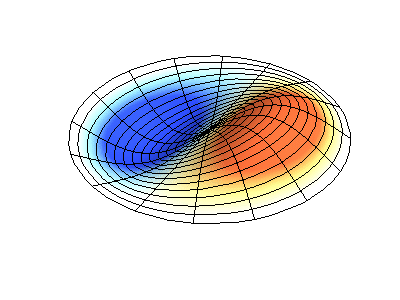


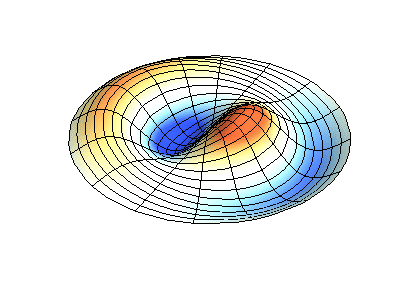
 Normal vibrations of a circular membrane with fixed edges. Source of
Normal vibrations of a circular membrane with fixed edges. Source of
Nodal lines are shown in green.
In a round membrane, the nodal lines, which are circles and segments along the radii, can intersect at right angles. If the edges of the membrane have an arbitrary shape, finding the frequencies of normal vibrations and pictures of their nodes and antinodes turn into a task that can be solved only with the help of a computer.
Profiles of the amplitude of oscillations of standing waves on square- shaped membranes with a hole , Koch snowflakes and the surface of a kitten .
The equations describing the vibrations of a thin elastic plate differ from the equations of the oscillation of the membrane, since the plate has its own rigidity, while the membrane is soft and springy only due to tension by external forces. However, there also exist sets of normal vibrations, the drawings of which essentially depend on the shape of the boundaries.
Figures Chladni
As mentioned above, in the general case, body vibrations are a combination of a whole set of normal vibrations excited in it. The phenomenon of resonance allows one to selectively initiate any one normal oscillation we need - to do this, one should swing the body with the help of an external force with a frequency equal to the natural frequency of the normal oscillation.
The two videos below show a typical scheme for obtaining Chladney figures: an elastic plate is attached in the center to a generator of mechanical vibrations, the frequency of which is gradually increased. Normal oscillations of the plate with their pictures of nodes and antinodes are excited when the oscillator frequency resonates with the natural frequencies of these oscillations (the natural frequencies are shown in the video in the lower left corner).
Here is a version of the same video, in which the frequency of normal vibrations can be assessed by ear.
And here is a little prettier.
We see pictures of knots and antinodes due to the fact that the air flows near the oscillating plate blow sand particles to the nodal lines of a standing wave. (*) Thus, the figures of Chladni show us the pictures of the nodal lines of normal vibrations of the elastic plate.
Several figures of Chladni on the top deck of the guitar. Source of
Another example of normal waves is standing waves on the surface of the water. They are described by an equation that differs from the equations of vibrations of plates and membranes, but they follow the same qualitative regularities, and with their help, analogs of Chladney figures can be obtained.
Microparticles on the surface of water in vessels of different shapes. The black line shows a scale of 2 millimeters. Source of
Classic chaos
So, we have seen that in the case of a circular membrane, the nodal lines are theoretically! - remarkably intersect, at the same time, on the Chladni figures on square or more complex plates, the nodal lines avoid intersections. To understand the reason for these patterns, we will have to make a short excursion into the theory of chaos.
Classical chaos is a property of mechanical systems, consisting in an extremely strong dependence of the trajectory of their movement on changes in the initial conditions. This relationship is also known as the “ butterfly effect ”. A striking example of chaotic behavior can be found when trying to predict the weather: a system of equations describing the movement of the atmosphere and oceans does not allow for sufficiently accurate predictions at large times due to exponentially increasing errors due to small inaccuracies in the source data (**)
The phenomenon of chaos was discovered and popularized by the meteorologist and mathematician Edward Lorenz , who discovered that the two weather forecast calculations, starting with very close initial conditions, are almost indistinguishable from each other at first, but from some point begin to radically diverge.
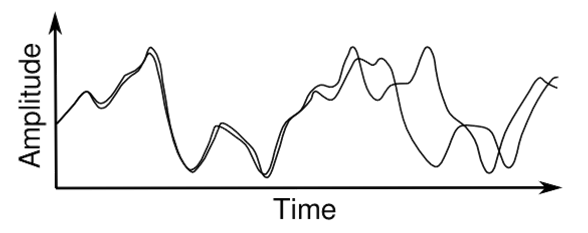
Two calculations by Edward Lorenz, coming from close initial values of 0.506 and 0.506127. Source of
The simplest systems, by the example of which it is convenient to study chaos, are billiards - areas of a flat surface, along which a ball can roll without friction, absolutely elastically bouncing off rigid walls. In chaotic billiards, the trajectories of the ball, with minor differences at the very beginning, further diverge significantly. An example of chaotic billiards is the Sinai billiards shown below, which is a rectangular billiard with a circular obstacle in the center. As we will see, due to this obstacle, billiards becomes chaotic.
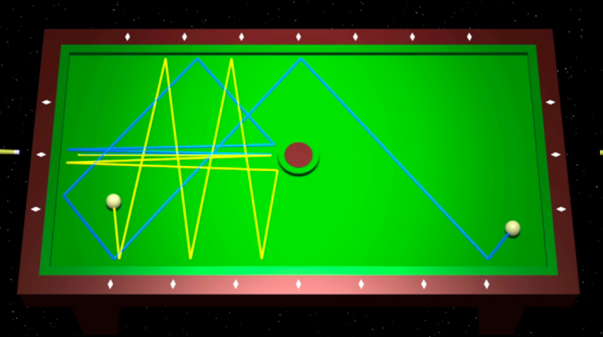
Two exponentially diverging trajectories of a ball in Sinai billiards. Source of
Integrable and chaotic systems
Mechanical systems that are not chaotic are called integrable , and using billiards as an example, we can clearly see the difference between integrable and chaotic systems.
Rectangular and round billiards are integrable due to their symmetrical shape. (***) . The movement of the ball in such billiards is simply a combination of two independent periodic motions. In a rectangular billiard, these are movements with bounces from the walls horizontally and vertically, and round this movement along a radius and angular movement along a circle around the center. Such a movement is easily calculated and does not show chaotic behavior.
Trajectories of the ball in integrable billiards.
Billiards of more complex shape, not possessing as high symmetry as a circle or a rectangle, are chaotic (****) . One of them we saw above is the Sinai billiard, in which the symmetry of a rectangle is destroyed by a circular inclusion in the center. Also often considered are billiards "stadium" and billiards in the form of Pascal's snail. The movement of the ball in chaotic billiards occurs along very confused trajectories and is not decomposed into more simple periodic movements.
The trajectory of the ball in chaotic billiards "stadium" and "Pascal snail".
Here you can already guess that the presence of intersections between the lines on the Chladni figures is determined by whether the plate has the form of an integrable or chaotic billiard. This is clearly seen in the photos below.

Round plates Chladni, demonstrating the properties of integrable billiards. Source of

Demonstrating the properties of chaotic billiards Chladni plates in the form of a billiard "stadium", the body of a violin and a square, the symmetry of which is broken by a round fixture in the center (analogous to Sinai billiards). Source of
Quantum chaos
How to understand why the presence of intersections between the nodal lines due to the integrability of billiards? To do this, turn to the quantum theory of chaos , which unites the theory of chaos with the mechanics of oscillations and waves. While in classical mechanics, a ball in a billiard is described as a material point moving along a certain trajectory, in quantum mechanics its motion is described as the propagation of a wave obeying the Schrödinger equation and reflected from the walls of the billiard.
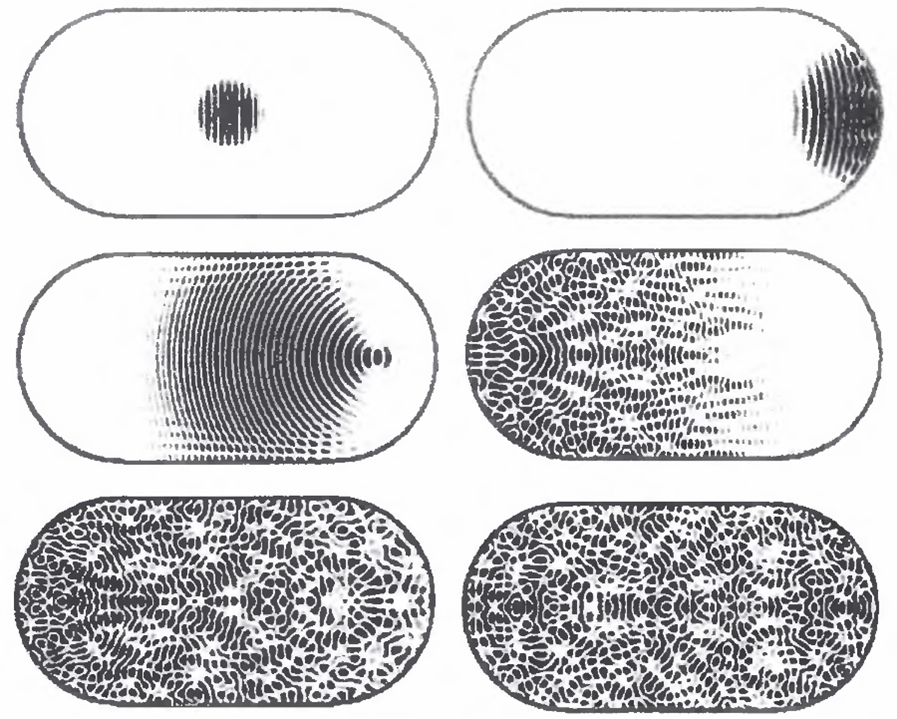
Stages of wave propagation in quantum billiards. Initially, the wave is concentrated in a round-shaped impulse and moves from left to right, then it spreads and repeatedly re-reflects from the walls. Source of
The same in the form of animation, but with slightly different initial conditions.
As in the case of oscillations of membranes and plates, the Schrödinger equation, which describes quantum billiards, allows us to find normal oscillations in the form of standing waves, which have a characteristic pattern of node lines and antinodes that are individual for each oscillation and depend on the shape of the boundaries.

Examples of oscillation amplitude profiles in standing waves in chaotic quantum billiards " Pascal snail " and " stadium ".
Figures of standing waves in integrable and chaotic quantum billiards are qualitatively different: integrable billiards show symmetric, ordered patterns of standing waves, while in chaotic billiards standing wave patterns are very intricate and do not show any visible patterns (at the end of the article it will be shown that some interesting patterns there still exist).

The amplitudes of oscillations in the standing waves of an integrable round billiard (top row) and chaotic billiards in the form of a Pascal snail (bottom row). Source of

Fancy pictures of normal vibrations in chaotic billiards are sometimes the subject of a separate study. Source of
The qualitative difference can also be seen in the pictures of nodal lines: in the case of integrable quantum billiards, we see ordered families of mutually intersecting lines, and in chaotic billiards these lines, as a rule, do not intersect .
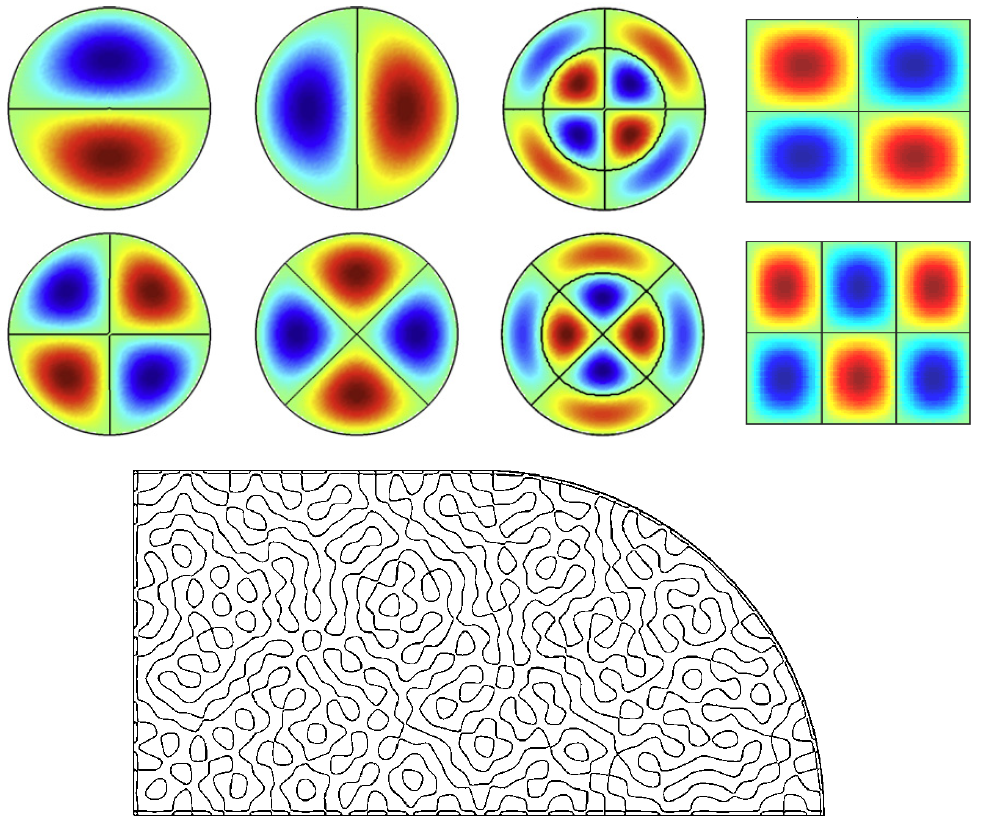
Above: nodal lines (black lines between blue and red areas) of standing waves of integrable - round and rectangular - billiards. Below: the nodal lines of one of the standing waves in chaotic billiards - a quarter of the billiard "stadium" .
Intersect or not intersect?
Why do the nodal lines in chaotic billiards not intersect? In 1976, the mathematician Karen Uhlenbeck proved a theorem according to which the nodal lines of standing waves of quantum billiards, generally speaking, should not intersect.
In a simplified form, this can be shown as follows: suppose that two nodal lines intersect at the point ( x 0 , y 0 ). For this to happen, the function f ( x, y ), which determines the dependence of the amplitude of the standing wave on the coordinates, must simultaneously satisfy three conditions:
1) It must be zero at the point ( x 0 , y 0 ), since this point is a nodal point.
2) If we move from the point ( x 0 , y 0 ) in the direction of the first nodal line, then f ( x, y ) should remain equal to zero.
3) If we move from the point ( x 0 , y 0 ) in the direction of the second nodal line, then f ( x, y ) must also remain equal to zero.
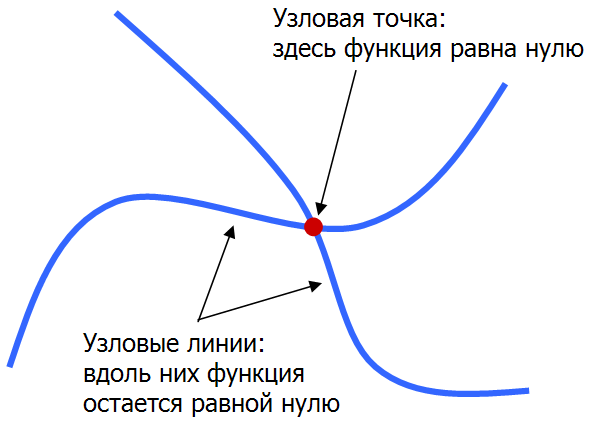
Total we have three conditions (or three equations) imposed on the function of two variables f ( x, y ). As we know, one equation is not enough to completely find two unknowns x and y , two equations are enough for this, and three equations are too much. The system of three equations for two unknowns, generally speaking, will not have solutions, unless we happen to be lucky. Therefore, the intersection points of the nodal lines can only exist as an exception .
In integrable billiards such exceptions just arise. As we saw above, their special properties — predictability of motion, absence of chaos, regular patterns of standing waves — are a consequence of their high symmetry. The same symmetry ensures the simultaneous fulfillment of three conditions necessary for the intersection of the nodal lines.
Let us now take a closer look at examples of Chladney figures typical of integrable and chaotic billiards. The figure below shows three characteristic cases . The plate on the left has the shape of a circle, so the corresponding quantum billiard is integrable, and the nodal lines intersect with each other. The plate is rectangular in the center, which also corresponds to an integrable system, but the round fixture in the center slightly violates the symmetry of the rectangle, therefore the nodal lines intersect not everywhere. On the right is an example of a purely chaotic system: a plate in the form of a quarter of Sinai billiards (in the upper right corner there is a circular notch), the node lines on which are no longer intersecting.

Thus, the stronger the shape of the plate - taking into account its attachment - is different from the shape of the integrated billiard (such as a circle or a rectangle), the less intersections of the nodal lines on it .
It’s not so easy to get beautiful Chladney figures with intersecting lines on a round plate. When oscillations are excited with central fastening, the circular symmetry of the entire system prohibits the formation of radial nodal lines, so we will see only a boring set of circles (this difficulty can be circumvented by exciting vibrations not from the center, but from the edge of the plate using the bow from the violin) If the plate is not fixed in the center, the figures of Chladni will become more interesting, but due to the violation of circular symmetry, the system will cease to be integrable.
Round plate, mount in the center.
Round plate, mount shifted from the center.
And here are different options with round and non-circular plates.
Finally, an attentive reader may notice: but I see that sometimes the nodal lines intersect even on “chaotic” plates. How so, if their intersection is prohibited by the Uhlenbeck theorem?
First, the nodal lines can avoid the intersection, but before that they come so close together that, because of the finite width of the sand track, it will seem to us that there is an intersection. Secondly, between integrable and chaotic systems there is in fact no sharp boundary.
Nodal lines - they separate black and white areas - in the integrable and chaotic quantum billiards (left and right), and in the intermediate pseudo-integrable case (in the center). In the intermediate case there are several intersections of the nodal lines, while in the chaotic case there are none at all. Source of
In the classical theory of chaos, the famous Kolmogorov-Arnold-Moser theory is devoted to this question. She says that if you slightly break the symmetry of the integrable system, it will not immediately show chaotic behavior, and, for the most part, will retain its property of predictability of movement. At the level of quantum theory of chaos and Chladni figures, this is manifested in the fact that in some places the intersections of the nodal lines are preserved. This happens either at particularly symmetrical points of the billiard, or far from the source of disturbance that violates the symmetry of the integrable system.
What else?
What else is interesting quantum theory of chaos? For the interested reader, I will mention three additional questions that are no longer directly related to the Chladni figures.
1) An important phenomenon studied by this theory is the universality of chaotic systems. The vast majority of systems in which normal oscillations can occur are chaotic, and all of them - regardless of their physical nature! - obey the same laws. The phenomenon of universality, in which completely different systems are described by the same formulas, is in itself very beautiful and serves as a reminder of the mathematical unity of the physical world.
Statistics of distances between adjacent frequencies of normal oscillations in chaotic systems of different physical nature, everywhere described by the same universal Wigner-Dyson formula. Source of
2) The patterns of normal vibrations of chaotic billiards have an interesting feature called “quantum scars” . We have seen that the trajectories of the ball in a chaotic billiard usually look very confusing. But there are exceptions - these are periodic orbits , fairly simple and short closed trajectories along which the ball makes a periodic movement. Quantum scars are called sharp condensations of standing waves along periodic orbits.

Quantum scars in the "stadium" billiards, running along periodic orbits, shown by red and green lines. Source of
3) So far we have talked about two-dimensional systems. If we consider the propagation of waves in three-dimensional space, then there can also be nodal lines along which the amplitude of oscillations is zero. This is especially important in the study of Bose condensation and superfluidity, where thousands of atoms move as single “ waves of matter ”. Analysis of the structure of nodal lines of matter waves in three-dimensional space is necessary, for example, to understand how quantum turbulence arises and develops in superfluid systems.
The entangled three-dimensional structures of the nodal lines of standing "waves of matter" in the Bose condensate. Source of
(*) If the size of the particles poured on the plate is small enough, they will be blown away not to the nodes, but to the antinodes of the standing wave, as was shown in this experimental work .
(**) «» «» , : – , , . .
(***) – . , , , .
(****) the If Expressed more Precisely, the then the Belonging of billiards or Chaotic integrable to the depends on the number of independent of Integrals are of motion - the Quantities That REMAIN over time. Integrable billiards have two integrals of motion; The theory of motion equations. The kinetic energy of the ball.
All Articles